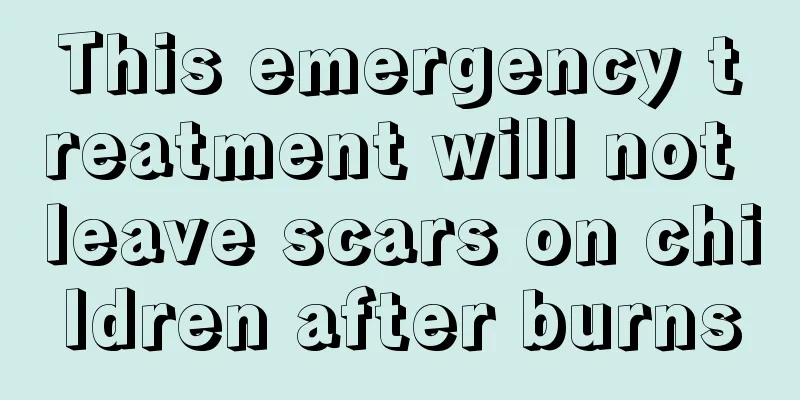Symptoms of pyloric stenosis in babies

|
Pyloric stenosis is a relatively common gastrointestinal disease. If pyloric stenosis occurs, the baby will experience symptoms of vomiting. If it continues for a long time, the baby will suffer from malnutrition, weight loss, decreased resistance and other physical health problems, which poses a great threat to the baby. If your baby has pyloric stenosis, he or she must be sent to the doctor for treatment immediately, and surgery is the main way to treat pyloric stenosis. Here is some information about baby's pyloric stenosis. 1. Symptoms of pyloric stenosis in babiesSymptom 1: Projectile vomiting Newborns with pyloric stenosis often experience vomiting 2-3 weeks after birth, initially vomiting several times a day without any regular pattern. Later, as the degree of stenosis worsened, it gradually developed into projectile vomiting shortly after each feeding. The vomitus mainly consists of curds, sometimes with gastric juice and stagnant food. The amount of vomitus can be greater than the amount eaten in one meal. Some children with severe vomiting may vomit blood due to rupture of capillaries in the gastric mucosa, and the vomitus is brown. Soon after vomiting, the child will want to eat again because of hunger. If the newborn's pyloric stenosis is severe, he will continue to vomit. Therefore, he cannot eat because of repeated or continuous vomiting, which leads to weight loss, malnutrition, decreased resistance, and susceptibility to infectious diseases. Symptom 2: There is a spherical bulge in the upper abdomen Due to the presence of pyloric stenosis, a spherical bulge may be seen in the upper abdomen of a newborn after feeding or before vomiting, moving from under the left rib to the right and disappearing to the upper right side of the navel. This peristaltic wave is caused by the contraction of the stomach wall muscles, so whenever stomach peristalsis occurs, the sick child becomes restless and cries incessantly. If the doctor presses deeply on the right upper abdomen with his hand when the child is fasting or has a soft abdomen, about 80% of the patients can feel an olive-sized, hard, cartilage-like mass at the lower edge of the liver. This is the hypertrophic pylorus.
1. Continuous vomiting half an hour after feeding. 2. The baby feels hungry (especially after vomiting). 3. The baby urinates and defecates less than usual. 4. The baby has symptoms related to dehydration. 5. The baby loses weight. 6. The baby feels tired and often drowsy. 7. The child has symptoms such as tetany.
1. Send to doctor for treatment: If a one-month-old baby still vomits violently and loses significant weight, it is not curable to just give the baby medicine. The mother should take the baby to the hospital for diagnosis. To diagnose this disease, barium can be placed in the baby's stomach for X-ray examination. If it is determined that it is caused by hypertrophic pyloric stenosis, the only treatment is surgery for the baby. 2. Surgical treatment: Pyloromyotomy is usually performed to remove the exit obstruction and cure the disease. (1) In the early days, three holes were made in the abdomen, one 5 mm and two 3 mm. Now, minimally invasive, laparoscopic surgery is used, with a single hole through the navel. The operation only takes 15 minutes. After suturing, no scar will be visible after the navel heals. (2) This surgery is very safe, has no risks, and can be recovered quickly. Therefore, even a baby as young as one month old can undergo the surgery without worries. (3) Especially for surgery for hypertrophic pyloric stenosis, it must be performed when the baby is in very good physical condition, that is, it is most appropriate to perform the surgery when the baby is not infected with any other diseases, has normal body functions, and has no nutritional imbalance. 3. Postoperative care: Generally, children can start drinking water 6 hours after surgery and usually can eat milk the next day. If all goes well, they can be discharged from the hospital 48 hours after surgery. After the operation, the child's milk intake gradually increased, starting from 10-20 ml each time, and then gradually increased. After the child is discharged from the hospital, parents should not let the child eat too much at once, but should gradually increase the amount. Many parents are concerned about wound issues. Generally, the dressing on the wound is changed once every 3 days and 7 days after the operation. If the wound heals well, you can take a normal bath about ten days after the operation. |
<<: What are the symptoms of baby's bloating?
>>: Symptoms of intracranial infection in children
Recommend
TCM treatment of pruritus in children
Many people have experienced itchy skin, and ever...
Two-year-old baby anal pain
A two-year-old baby has anal pain, which is often...
Factors that cause babies to cry suddenly while sleeping
Babies crying at night has become a headache and ...
What are the contraindications of Bodilan Anti-inflammatory Tablets?
Bodilan Anti-inflammatory Tablets are a Chinese p...
What to do if your child's glasses are red and swollen
Children often do not pay attention to hygiene wh...
What factors affect a child's height?
Height is the first criterion for appearance and ...
How to bask in the sun when the baby has jaundice
When it is confirmed that your baby has jaundice,...
What should I do if my child has diarrhea in the middle of the night?
As we all know, the gastrointestinal function of ...
What methods can quickly treat baby's cough?
Modern people will encounter this problem, why th...
What to do if your baby is allergic to milk
Babies need sufficient nutrition as they grow, an...
3 year old child cannot speak
Some children who are already three years old are...
Can children drink carbonated drinks?
Many children like to drink carbonated drinks, es...
Why are the skin on my child's palms peeling?
Children's health is a concern for parents. I...
How to deal with a child who has a cold and cough
All children love to go out and play. They hope t...
What are the dietary treatments for acute gastroenteritis in children?
If a child has acute gastroenteritis, parents may...









